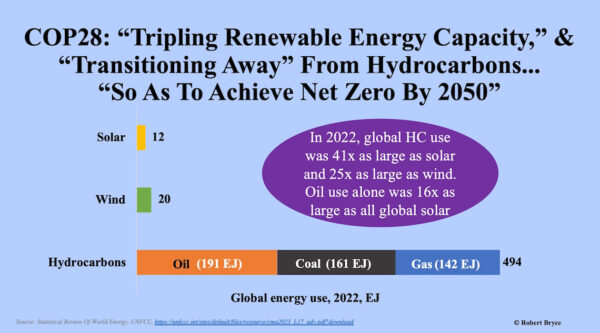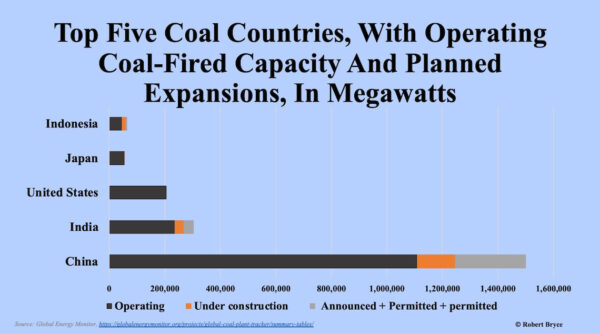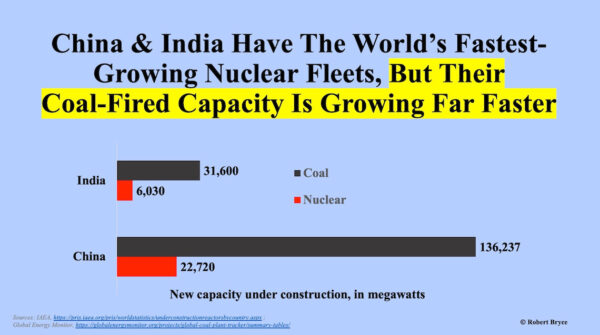You wouldn’t know it from reading the newspapers, but that is what we are living in. The recently-concluded COP28 conference touted a coming end to the use of fossil fuels, with coal first in line for extinction. But that isn’t happening. Robert Bryce has the data:
The [International Energy Agency] expects coal use to rise by 1.4% this year and set a new record of 8.5 billion tons.
So more coal is being burned than ever before.
That increase shows, yet again, how difficult it will be to achieve significant cuts in CO2 emissions from hydrocarbon use. Mainly due to coal use, which accounts for about 40% of emissions from energy, global CO2 emissions will set another new record in 2023 of 36.8 billion tons.
So good luck with “net zero” by 2050, or any other date. Environmentalists in the U.S. and Western Europe have succeeded in prematurely shuttering a number of coal plants, but that is virtually irrelevant. It is China and India, along with countries like Indonesia, that are driving the coal explosion. And those countries don’t even pretend to be participating in a “transition” to wind and solar energy:
China, India, and Indonesia didn’t sign the agreement to triple renewables.
But in any event, even a tripling in energy from renewables–which isn’t happening–would scarcely make a dent in the world’s demand for fossil fuels, as this chart by Bryce shows:

When it comes to coal, supposedly slated for extinction by the world’s “greens,” the U.S. and Western Europe are irrelevant.
Some 204,000 megawatts of new coal-fired capacity is now under construction around the world. Of that 204,000 MW, about 67% is in China. To put that massive amount of new capacity in perspective, the U.S. currently operates about 205,000 MW of coal-fired power plants… In addition to the huge amount now being built, another 353,000 MW of coal-fired capacity has been announced, pre-permitted, or permitted. Of that 353,000 MW in the queue, about 72% is in China.
This chart shows coal capacity in existence, and on the drawing board. The U.S. could close all of our coal-fired power plants; it wouldn’t matter:

If people are serious about cutting down on CO2 emissions, the only rational solution is nuclear energy, because wind and solar don’t work most of the time and are ridiculously expensive. At COP28, many nations, including the U.S., pledged to triple their nuclear capacity. That’s great, but the reality is that coal is growing much faster than nuclear, and will continue to do so for the foreseeable future:


Robert Bryce points out that Michael Bloomberg has donated more than $1 billion to a campaign called “Beyond Carbon,” which is trying to shut down 40% of all U.S. electricity production. There is no replacement for this capacity on the horizon:
Bloomberg and his allies at the Sierra Club, League of Conservation Voters, Rocky Mountain Institute, and Earthjustice, are launching their campaign to shutter all of our coal plants despite numerous warnings from grid operators, federal authorities, and trade groups that the U.S. grid is facing serious reliability challenges.
For instance, Federal Energy Regulatory Commission chairman Willie Phillips told the Senate Energy and Natural Resources Committee in May, “We face unprecedented challenges to the reliability of our nation’s electric system.”
The challenges are unprecedented because until now, no one has done anything as stupid as shutting down vast quantities of reliable electric power while having no plan replace that capacity, on any timetable or at any cost. But that is where we are now. Given that U.S. emissions are essentially immaterial to global CO2 emissions, in view of what China, India, Indonesia and other countries have in progress, one can only question the motives of those who want to cripple our economy and our children’s futures with pointless “green” mandates.
If you follow the first link above, it will take you to Robert Bryce’s Substack. You should sign up for his emails, too. You will learn more about energy policy here than from virtually any other source. Also, check out the paper Robert wrote for American Experiment, on the insuperable land use issues that stand in the way of wind and solar energy development on anything like the scale that would be required to try to replace fossil fuels.
Notice: All comments are subject to moderation. Our comments are intended to be a forum for civil discourse bearing on the subject under discussion. Commenters who stray beyond the bounds of civility or employ what we deem gratuitous vulgarity in a comment — including, but not limited to, “s***,” “f***,” “a*******,” or one of their many variants — will be banned without further notice in the sole discretion of the site moderator.